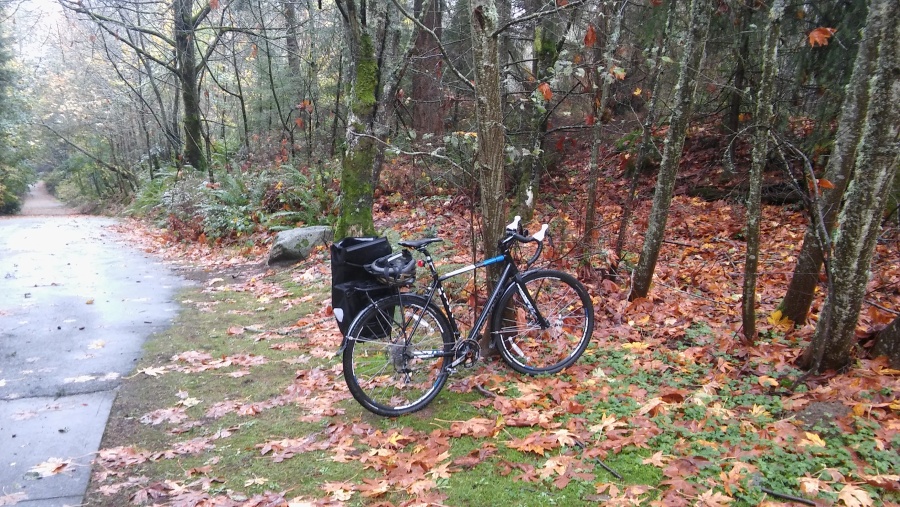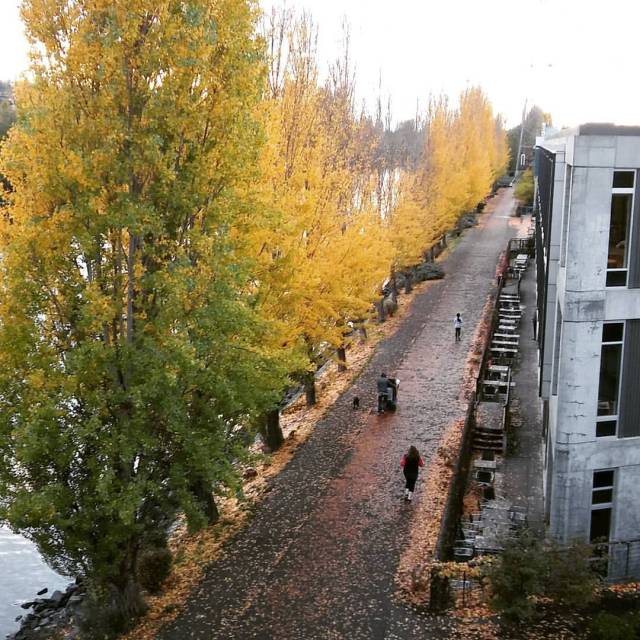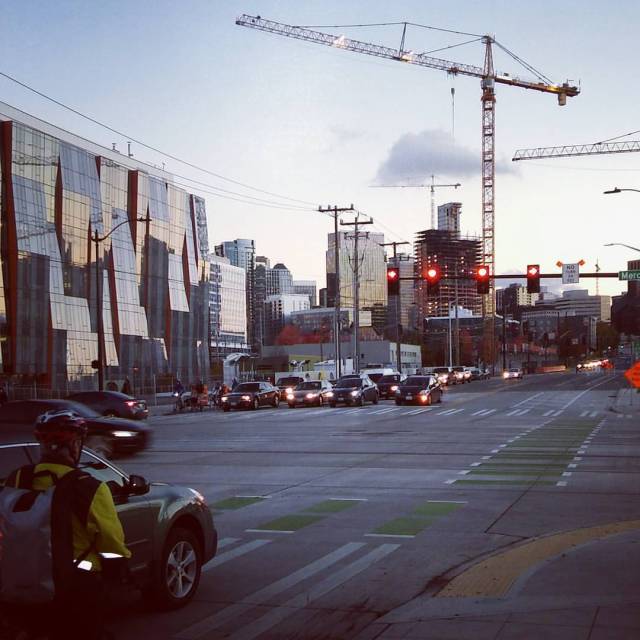Mayor Jenny Durkan took office on November 28, 2017, the first female mayor in Seattle since Bertha Knight Landes in 1928 and the first lesbian to hold the position. Her election followed a tumultuous several months, with Ed Murray resigning due to allegations of serial sexual assault. She was sworn into office as soon as the election results were certified, due to the interim nature of then Mayor Tim Burgess.
Durkan, a career prosecutor and US Attorney under Barack Obama, ran in the general election against Cary Moon, a waterfront activist and urban planner. Both candidates ran on similar themes of an inclusive, compassionate future for the city, with strategies to address issues such as housing affordability, homelessness, and transportation. Despite broad similarities between the platforms of the candidates, Durkan was widely viewed as the conservative, “establishment” candidate, while Moon was viewed as more progressive.
In terms of the personality contrast between Moon and Durkan, after attending a candidate forum local dude Zach Stednick sent the following analysis. “Cary Moon is like the cool aunt who you hope lets you smoke weed with her, and Jenny Durkan is like the awkward, high-achieving coworker.”
Put into the parlance of our time, the hot take, I think the fear among Seattle’s left wing was that Durkan would readily cave to the menacing whispers of the Chamber of Commerce and traditional neighborhood groups. I also heard lots of concerns as to the continuation of the often-criticized “sweeps” of unauthorized homeless encampments. For a while the hashtag “#jennyonebutdurkan” was showing up on social media, and I got the sense that some folks on the left were more worried about Durkan as some sort of Trojan Horse for Big Tech and NIMBY’s than they were excited about Moon.
Several commentators more perceptive than me have observed that the Seattle left divides roughly into camps of socialism and urbanism. At a simplistic level, the distinction is people concerned primarily with equity vs with the proper functioning of cities. From my perspective it seems like there’s quite a bit of overlap between the policy prescriptions of these two groups, so it’s sometimes surprising how much they seem to hate each other. Both would have us vastly improve public transit while building lots of housing and divesting from fossil fuels, although the specifics vary. The urbanists seem more focused on market dynamics, while the socialists prioritize issues such as police reform, education, and equity for marginalized groups. My read on the situation is that the equity folks get frustrated with the urbanists for being a bunch of well-heeled white dudes, often working in the hated tech industry and living north of the ship canal with all the attendant obliviousness of those conditions, while the urbanists get frustrated with the socialists for advancing what they believe to be counterproductive proposals (rent control, anything that whiffs of “putting the boots to the greedy developers”) and taking up combative, absolutist stances.
This is all to say that Seattle’s socialist left didn’t really have a candidate in this general election. Durkan played the role of consensus building centrist while Moon roughly represented the urbanist left. Again, delving into take-level insights, it seemed as though the Moon natural constituency was made up of highly educated, asset-poor white people who read The Stranger, while Durkan’s coalition was anybody who reads the Seattle Times, owns a home, has a water view, or, preferably, all three. Nikkita Oliver, a candidate in the primary from The People’s Party of Seattle, energized the socialist left but narrowly failed to advance to the general election, and it wasn’t clear to what extent her supporters would rally behind Moon. Surely they would want #jennyonebutdurkan, but how excited would they be to vote for one millionaire white lady over another? Upzones, transit, and high-minded urban theory might sound like heaven to a newly minted STEM brah, but to a cynical, long-term resident of a lower-income neighborhood, it might sound like a familiar pattern of ridiculous white people moving in, and kicking you out.
I would also argue, though, that while the socialist left didn’t have a dog in the hunt, neither did the Laurelhurst right. There really was no Seattle Times Editorial Board candidate, someone promising less traffic, more free parking, and lower property taxes. Even in the crowded primary, none of the credible candidates were promising to rip out bike lanes, downzone urban villages, or imprison all of the homeless people. As the allegedly conservative candidate, Jenny Durkan ran on a platform that likely sounded hideous at times to the classic Seattle homeowner. She spoke in very frank terms about the need to get people out of their cars to accommodate a booming population on a fixed amount of urban road space, something sure to inflame the “War On Cars” crowd. And, I mean, this is literally a passage from her campaign issues page:
5. Diversify and expand housing options
We should always be looking at innovative ways to expand our housing options in the city. We need to explore more permitted mother-in-laws and accessory dwelling units. Housing options such as duplexes, townhouses, or courtyard communities can help grow a vibrant and robust community. I am interested in exploring ways to make these additional types of housing more feasible in our city.
If the HALA process taught us anything, it’s that the hill for the craftsman homeowners to die on is preventing duplexes from appearing in their neighborhoods. I think that some of the concern with Durkan on the left wasn’t so much that she was saying the wrong things, but that she didn’t mean what she was saying, or would easily cave to powerful interests. So it really wasn’t quite so simple as Durkan being the Magnolia Bluff/Seattle Times Editorial Board candidate. The question was not just whether Nikkita Oliver’s supporters would rally to Cary Moon, but whether the wealthy water-view homeowners would rally to Jenny Durkan.
Well, Durkan won the election handily. Receiving 122,442 votes to Moon’s 95,251, Durkan won with 56.25% of the vote for a 12.5 point margin. Rich people vote, folks, and don’t you forget it.

Cary Moon saw strongest support in the Rainier Valley, Highland Park, Delridge, and Capitol Hill, as well as the U-District, Fremont, Ballard, and a smattering north of 85th, especially along the route 99 corridor. Basically everywhere else Moon got crushed. Following the established Seattle dynamics, water views and home ownership were risk factors for voting the candidate perceived as more conservative. Montlake, Broadmoor, Laurelhurst, Madison Park, Madrona, Upper Queen Anne, Magnolia, and West Seattle especially near the Sound went for Durkan in a landslide.
In what has become a Stats on the Street tradition, we can also view the precinct level turnout results, which is basically the same map. In fact I had to check several times to ensure that, no, I did not mistakenly create the same map twice. It just so happens that likeliness to vote is strongly associated with more conservative political views. Average turnout citywide was around 50%.

What I find most interesting about the pattern of turnout, and this is not unique to the November 2017 general election, is the low rate of voting around Amazon’s epicenter. South Lake Union and Lower Queen Anne south of Mercer stick out on this map just like Rainier Beach and the University of Washington. This sort of breaks the heuristic that wealthier people are more likely to vote. The area around Amazon HQ is chock full of recently constructed, mid-rise apartment buildings, renting studios to 2 bedrooms generally in the range of $2000-$3000 per month. Logically, these buildings must be occupied by tech workers making roughly six figures. Anywhere else in the city, folks working at jobs earning $100k+ would be much more likely to vote than the average citizen, so what’s going on here? It may be that many of the techies are recent transplants, still taking time to get their feet under them in a new home. It may also be that the tech industry’s spirit of disruption fosters a lack of faith or engagement in traditional institutions. These are questions not answerable by voting results, but it’s a trend to keep an eye on, the possible emergence of a class of high earners who forsake the electoral process. Here’s a zoomed in turnout map around South Lake Union.

There is one peculiar precinct, though, smack dab in the middle of low turnout SLU. The skinny, vertical rectangle colored bright green just above Amazon HQ is precinct 43-3700, a single block between Fairview and Minor stretching four blocks between Denny and Republican. I can’t for the life of me figure out why voter turnout in this precinct exceeded the rest of the neigborhood by over 20 points.
Citywide, though, it is an incredibly familiar story, a story that I imagine vexes progressive candidates and their campaign staffs. The people likely to vote for the more conservative candidate are also the people likely to vote at all. Dividing the precincts into six categories based on turnout gives the following table.
| Turnout | # Precincts | Durkan Vote Share |
| <40% | 169 | 46.2% |
| 40-45% | 112 | 48.7% |
| 45-50% | 145 | 51.7% |
| 50-55% | 168 | 55.7% |
| 55-60% | 195 | 62.3% |
| >60% | 189 | 67.1% |
In a typical low turnout precinct Moon won by 8 points. In a typical high turnout precinct Durkan won by 34 points. Every election season I wonder how society would look, function, and operate differently if poor renters voted in the same numbers as wealthy homeowners. This election wasn’t close enough to be swung by a surge in turnout among progressives, but many are.
Again, though, my caveat here is that Jenny Durkan’s alleged conservatism may have been more perception than reality. It is a peculiar Seattle phenomenon to view an accomplished lesbian and self-described progressive as a sellout, shill, and tool of the hated establishment. While it appears as though the Nikkita Oliver enthusiasm did not carry forward from the August primary to Cary Moon, the water view homeowners took up their civic duty as they always do, and filled in the bubble for the candidate who more closely matched their priorities and beliefs, even if I’m sure there were a few points of disagreement.
Because this is Stats on the Street, I also took a field trip to notable precincts. Specifically, the one that swung most to Durkan, the one that swung most to Moon, the one in which the results most closely mirrored the results citywide, and the mysteriously enthusiastic precinct in South Lake Union.
Most Durkan Precinct: 43-1821, Madison Park

| Registered Voters | 240 |
| Votes for Jenny Durkan | 135 |
| Votes for Cary Moon | 11 |
| Times Left Blank | 3 |
| Number of Write In | 0 |
| Times Counted | 149 |
First off, shoutout to the good people of Madison Park for making it basically impossible to get to their neighborhood. From my home in the U-District, Google Maps advised a 3 or even 4 seat ride(!) taking around an hour. For reference the trip is about 4.5 miles.
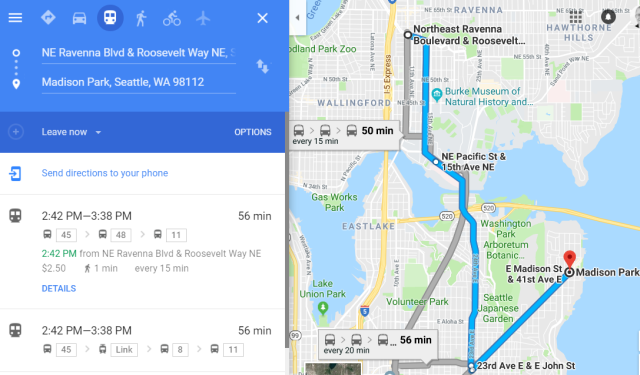
Jenny Durkan won this precinct in a landslide. Of the 149 ballots counted from 43-1821, 135 were cast for Durkan against only 11 for Cary Moon, an astounding 91% vote share. Here is a sampling of what that neighborhood looks like from street level.





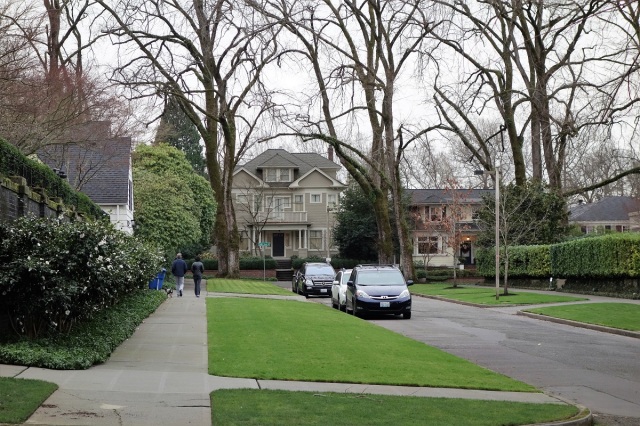


I’m always a little nervous photographing too many specifics, especially in an area like this, where residents may not cotton well to some bro showing up on a bicycle and walking around taking pictures. Really the best slice of life to capture would have been a picture of a wrought iron gate and security system warning sign. When I walk the neighborhoods I typically look for anything interesting or distinctive — yard art, signs, businesses — but this precinct seemed to contain nothing but impeccably landscaped palaces and empty streets.
Most Moon Precinct: 43-1849, Capitol Hill

| Registered Voters | 361 |
| Votes for Jenny Durkan | 32 |
| Votes for Cary Moon | 135 |
| Times Left Blank | 0 |
| Number of Write In | 1 |
| Times Counted | 168 |
Perhaps not surprisingly, the precinct that voted most overwhelmingly for Cary Moon lies in the heart of Capitol Hill. If ever there were a neighborhood to support an urbanist candidate — activist, planner, urban intellectual — it would be this one. In contrast to the sprawling expanse and irregular geometry of the most Durkan precinct in Madison Park, 43-1849 is a tidy, simple rectangle. Three blocks, bounded in one direction by Harrison and Thomas, and in the other by Broadway and Belmont. Of 168 ballots cast, 135 selected Cary Moon versus only 32 for Jenny Durkan, an 80% vote share. The precinct maps are to the same scale, and it is significant to consider that these three blocks of Capitol Hill contain 361 registered voters, whereas the spacious Madison Park precinct is home to only 240 registered voters in an area many times larger.






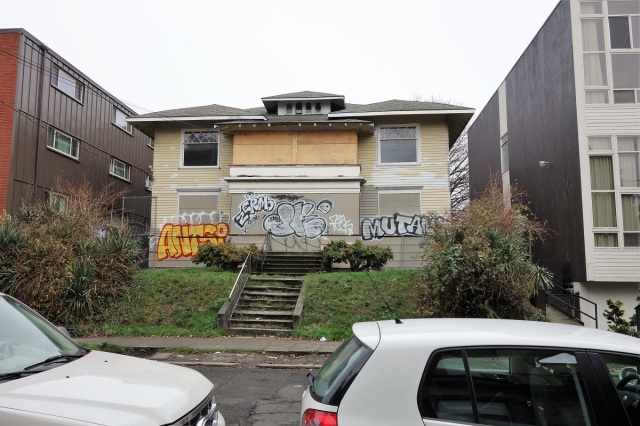
Most Representative Precinct: 36-1714, Lower Queen Anne

| Registered Voters | 541 |
| Votes for Jenny Durkan | 157 |
| Votes for Cary Moon | 122 |
| Times Left Blank | 11 |
| Times Over Voted | 1 |
| Number of Write In | 4 |
| Times Counted | 295 |
Precinct 36-1714 on the lower, western slopes of Queen Anne hill near Kinnear Park showed a vote split closest to the citywide results. Among the ballots cast for the two candidates, Jenny Durkan won 56.27% in this precinct as compared to 56.25% overall.
This precinct proved more interesting to visit than I would have guessed, as it straddles the “beamer line,” separating young people and renters in Lower Queen Anne from million-dollar-homeowners on the south slope of the hill. One might even say that precinct 36-1714 contains multitudes, everything from old brick apartment buildings to large mid-century condos, a variety of townhouses, and multi-million dollar single family houses with views of downtown. Bus stops and bike route signs collide with the decidedly single family flair of the higher slopes of the hill. It seems fitting that this precinct would most resemble the citywide results.

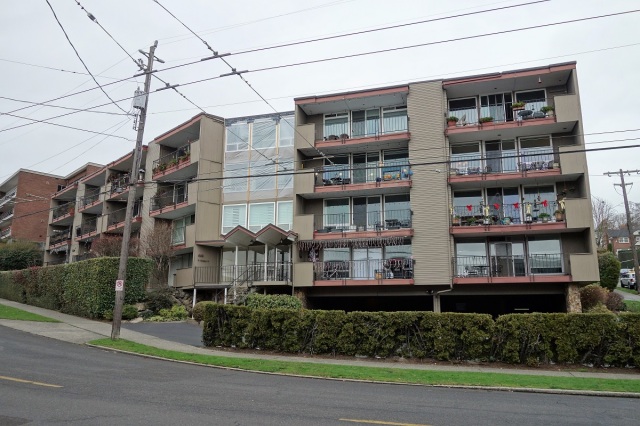






The High Turnout Precinct in Amazon Central: 43-3700, South Lake Union
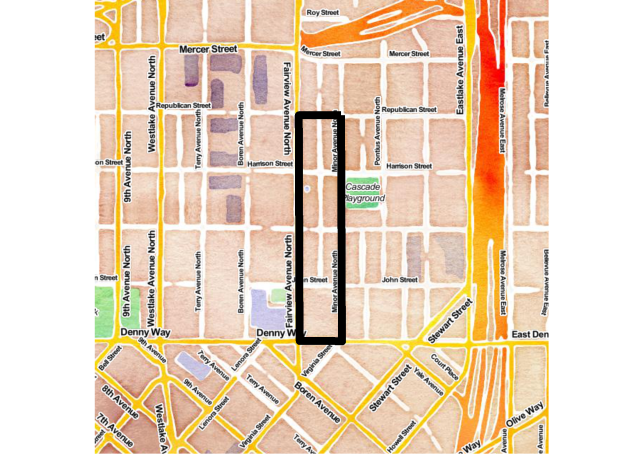
| Registered Voters | 608 |
| Votes for Jenny Durkan | 281 |
| Votes Cary Moon | 83 |
| Times Left Blank | 4 |
| Times Over Voted | 0 |
| Number of Write In | 4 |
| Times Counted | 372 |
This precinct was the sliver of high turnout in the sea of rarely voting tech workers. I extended my field trip to these four blocks of the newly energized South Lake Union neighborhood to look for any markers that might explain the unique voting pattern.
It turns out that there is a delicious explanation for the unusual concentration of conservative voters in a single precinct of South Lake Union. The absolutely massive 12-story apartment building, pictured first, in fact contains an assisted living community, Mirabella Seattle. It seems like an open and shut case, given that the rest of the housing seems to be apartments for tech workers.
However, it was fascinating regardless to spend some time at the sidewalk level in South Lake Union near Amazon HQ. The scale and swiftness of the neighborhood’s complete reinvention is a spectacle worth observing firsthand. The four blocks of precinct 43-3700 have been mostly redeveloped, but I included some pictures of current construction projects directly adjacent to get a better sense of the area. This is a visual expression of the capability of corporate America to funnel massive amounts of wealth from all over the country and world into a single location, facilitated by the neighborhood’s previous state of disinvestment. Without powerful neighborhood groups to stall and litigate construction, Amazon et al have been able to build with ferocity. Vestiges of the past remain, however, in scattered, boarded-up buildings and impoverished longtime residents.









Wrapping it Up
Spend enough time studying precinct level voting results and walking the neighborhoods, and it’s hard to shake the impression that Seattle’s economic system is something like feudalism. The Lords queue in luxury CUVs in a several block lineup outside The Bush School, and the serfs queue outside Dick’s on Broadway, if they’re lucky. What’s startling is just how close, geographically, these two worlds lie. Really only two miles separate the Moon precinct from the Durkan precinct explored above, but the chasm feels more significant than that. The explosive emergence of the technology industry within the city, led by Amazon dot com, seems to exaggerate this dichotomy, which is plainly visible in voting results from the 2017 mayoral race.
Despite the surface-level similarities between the two candidates, Seattle’s economic fault lines were in full display this election, with Durkan winning the wealthier and more conservative neighborhoods in a landslide. Moon performed best in areas of greater urban density and/or lower incomes, but not by enough to swing the election in her favor. It seems to be the case that Moon’s appeal to the urbanist left may have been too narrow, and with many similarities between stated policies and platforms, voters preferred the hard-charging, workaholic attorney to the activist and planner.







